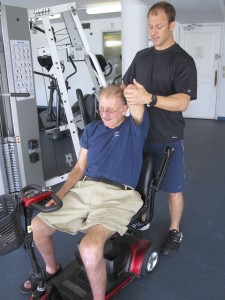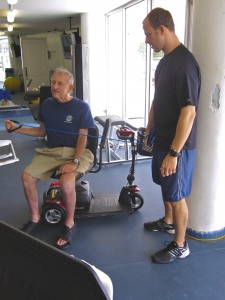That’s right, it’s never too late to begin exercising to improve your health. My client in the picture above is a 66 year old who hasn’t worked out consistently since his thirties. He had recently undergone a full knee replacement and suffered one of the worst things that can result following a surgery of that type: infection.
Even though he was for the most part confined to his scooter, he was determined to make a positive change in his health. He was unable to start physical therapy for his knee due to the infection but he still had his upper body to work with. The exercises that we would be able to do were limited because of of his physical limitations. Not only was he unable to work his lower body but his upper body was weakened from recovering from all the treatments he had undergone. His arthritic right shoulder further complicated the issue. With a little analysis and creative problem solving I was able to implement a program that would get him started on the right path.
First we started with a little warm up and some static stretching to to get his muscles ready for exercise. Stretching is particularly important for someone who has lost flexibility due to inactivity.
Then came specific exercises designed to improve his posture and functional strength while avoiding aggravating his arthritic shoulder. It’s not that difficult to find exercises that will work for someone who has physical limitations. Just find a range of motion that doesn’t hurt during or after an exercise.
Single-arm cable presses are a fantastic way to work the chest and other pushing muscles while minimizing joint stress or when laying on a bench isn’t possible.
Working the upper back muscles is always important for people who spend a lot of time in the seated position. Seated rows are a great exercise to accomplish this. The parallel grip is the easiest to use and is easy on the shoulder.
Some of the functional exercise proponents don’t like bicep curls but I feel they can be very beneficial. Bicep curls can be a great way to build bicep strength. An added bonus is if you have the person maintain good spinal alignment throughout the exercise, it can help improve posture as well.
A great exercise to help reverse hunched over posture is arm raises. Raising your arms over your head while lifting your chest will help you get the flexibility and postural endurance to sit or stand with good postural alignment.
Working the rotator cuff muscles is another very effective way to improve posture and shoulder mechanics. External rotations is one of my favorites for this.
My client has been steadily working on these exercises for the past two months. His strength and flexibility have improved substantially since our first training session. He is also beginning to notice his muscles develop even after being sedentary for thirty years. There is always something you can do to improve your fitness levels even if you can’t walk. Thanks to my client for sharing his story!












